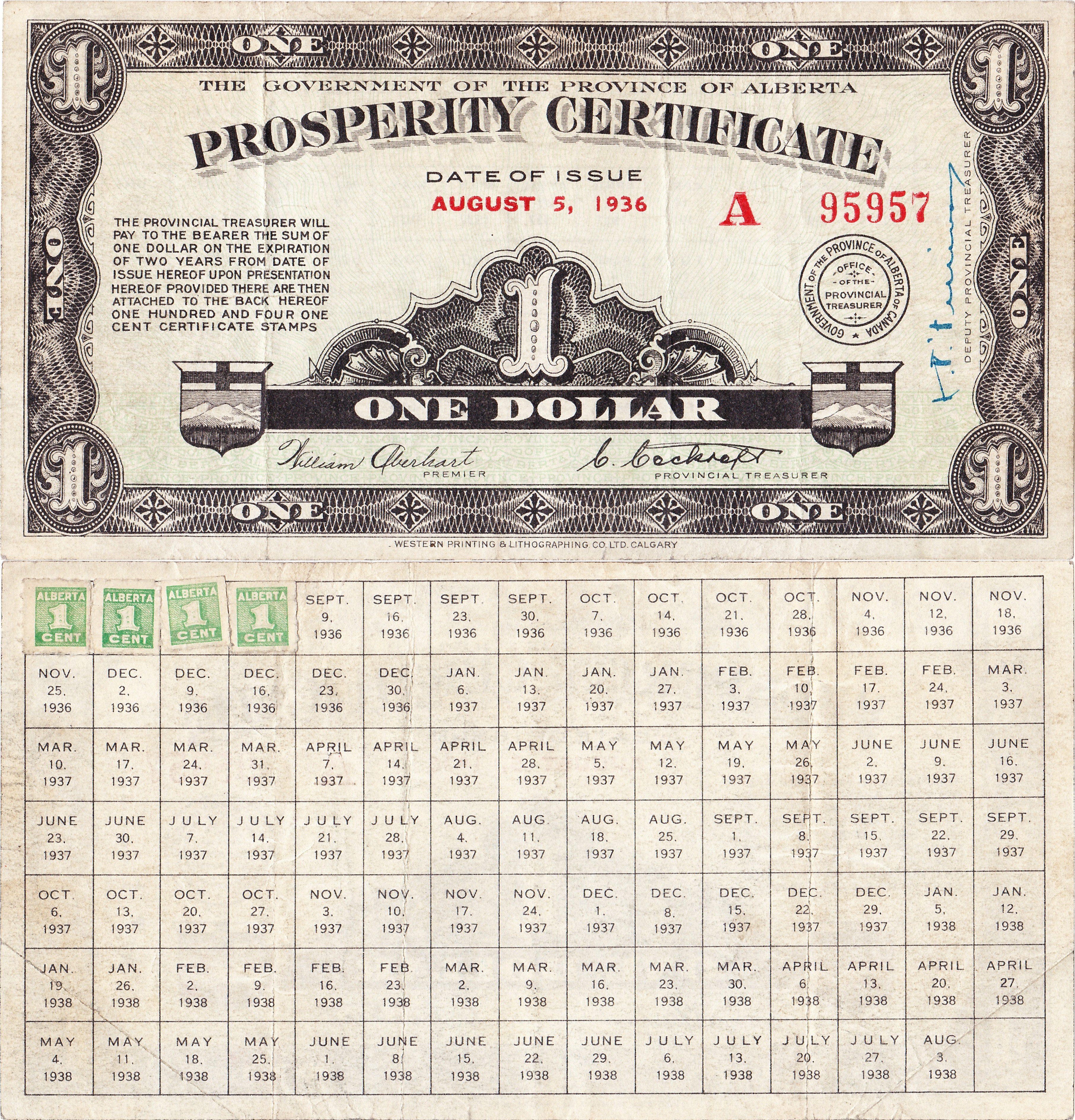Prosperity certificate on:
[Wikipedia]
[Google]
[Amazon]
 In 1936, the
In 1936, the
 In 1936, the
In 1936, the Alberta Social Credit Party
Alberta Social Credit was a provincial political party in Alberta, Canada, that was founded on social credit monetary policy put forward by Clifford Hugh Douglas and on conservative Christian social values. The Canadian social credit movement w ...
-led government of the Province of Alberta
Alberta ( ) is one of the thirteen provinces and territories of Canada. It is part of Western Canada and is one of the three prairie provinces. Alberta is bordered by British Columbia to the west, Saskatchewan to the east, the Northwest Ter ...
, Canada, introduced prosperity certificates in an attempt to alleviate the effects of the Great Depression. Premier William Aberhart
William Aberhart (December 30, 1878 – May 23, 1943), also known as "Bible Bill" for his outspoken Baptist views, was a Canadian politician and the seventh premier of Alberta from 1935 to his death in 1943. He was the founder and first leader ...
's government had won power in the 1935 provincial election partly on the scheme.
The certificates were not issued to the general public as Aberhart had promised in his election platform but instead were used to pay relief workers on provincial public works projects and were put into circulation via special agreements with municipalities.
Although not technically money, each certificate was marked with a value of one dollar
Dollar is the name of more than 20 currencies. They include the Australian dollar, Brunei dollar, Canadian dollar, Hong Kong dollar, Jamaican dollar, Liberian dollar, Namibian dollar, New Taiwan dollar, New Zealand dollar, Singapore dollar, ...
, and redeemable for $1 Canadian at the end of its life or on certain dates during the course of the program. Other certificates were in the amount of $5. $239,000 worth of scrip was issued in August 1936.
A goal of the program was to encourage spending and circulation of the spending power. To achieve this, hoarding of the certificates was discouraged by requiring the holder to affix to the back of a certificate a 1¢ stamp every week for the certificate to maintain its validity. Thus people were encouraged to spend whatever certificates they had each week, to avoid having to make too many payments of the one-percent tax. As the program intended, possessors of the certificates tried to avoid having to purchase and affix the stamps, by spending the certificates before the week's validity expired. This stamp scrip, innovated by Silvio Gesell, was not part of the theories of Aberhart's mentor, social credit
Social credit is a distributive philosophy of political economy developed by C. H. Douglas. Douglas attributed economic downturns to discrepancies between the cost of goods and the compensation of the workers who made them. To combat what he ...
founder Major C. H. Douglas.
The hassle and expense of the stamps made the certificates unpopular with the public. To make matters worse, the tiny gummed postage-style stamps (smaller than ) were prone to falling off.
Another issue was finding a seller who would accept the unusual currency. The Army & Navy Stores, a chain of department stores, accepted the currency when some other merchants would not. Oddly, the currency was not accepted by the government itself for payment of taxes.
The notes were intended to be redeemed after two years of issue, when 104 stamps would have been affixed. But the program was cancelled after only about one year. The notes could be returned to the government for redeeming in Canadian currency.Bruce Allen Powe, The Social Credit Program and the Alberta Treasury Branches, MA thesis, UofA, 1951
Alberta's prosperity certificates have never been listed in the Standard Catalog of World Paper Money.
See also
*Demurrage (currency)
Demurrage is the cost associated with owning or holding currency over a given period. It is sometimes referred to as a carrying cost of money. For commodity money such as gold, demurrage is the cost of storing and securing the gold. For paper curr ...
*Local currency
In economics, a local currency is a currency that can be spent in a particular geographical locality at participating organisations. A regional currency is a form of local currency encompassing a larger geographical area, while a community curren ...
*Freigeld
As part of the theory of Freiwirtschaft, Freigeld ('free money', ) is a monetary (or exchange) unit proposed by Silvio Gesell.
Properties
Freigeld has several special properties:
* It is maintained by a monetary authority to be ''spending- ...
* Silvio Gesell
*Social credit
Social credit is a distributive philosophy of political economy developed by C. H. Douglas. Douglas attributed economic downturns to discrepancies between the cost of goods and the compensation of the workers who made them. To combat what he ...
* Prosperity Bonus, also nicknamed ''Ralph bucks'' a 2006 $400 dividend to every Albertan
References
{{Social Credit Local currencies of Canada Currencies of Canada Social credit Economy of Alberta Canadian social credit movement History of Alberta 1936 in Canada Alberta Social Credit Party